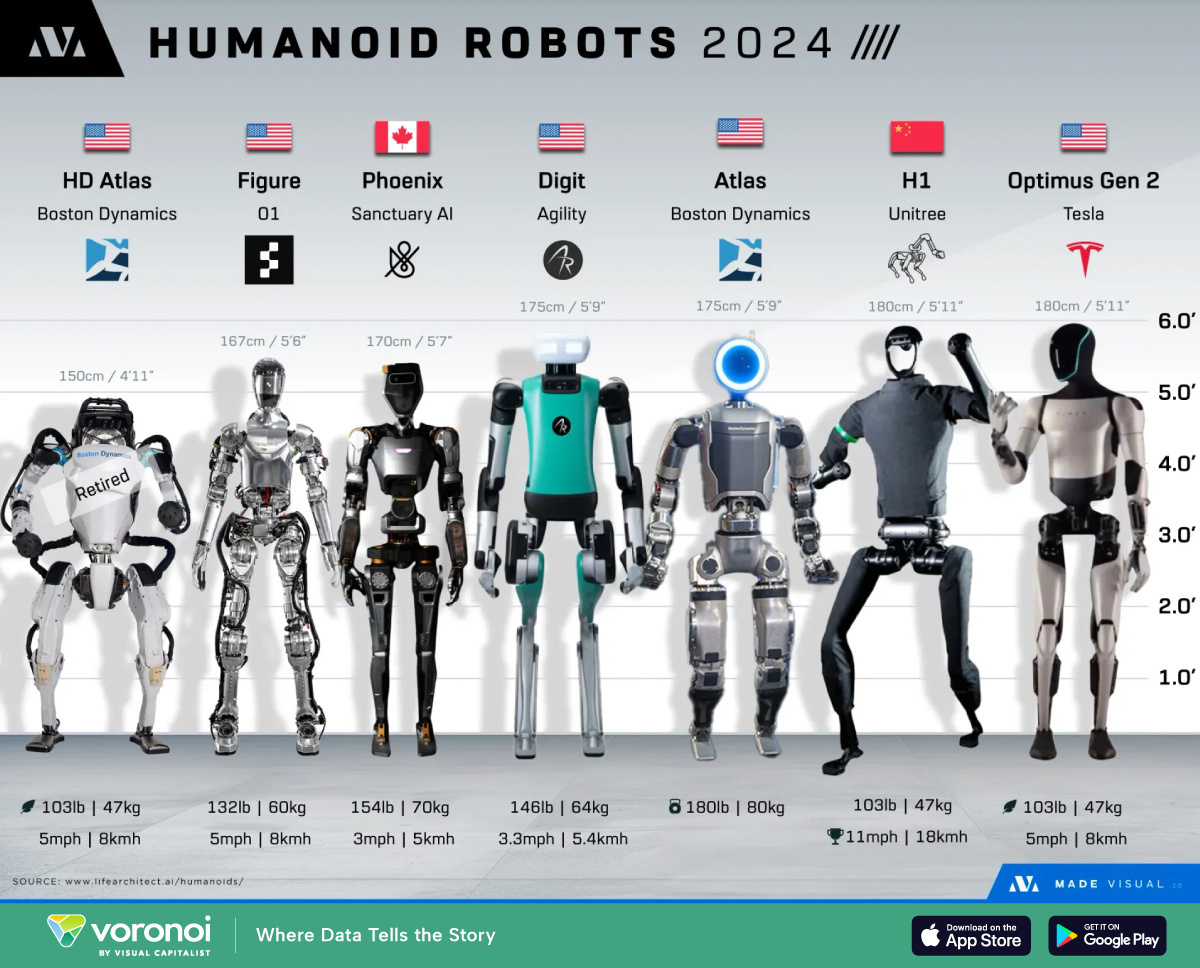
Think about robots. Do you picture shiny metal humanoids from movies, or do you see the quie...
Robots the future is here
12 minutes, 5 seconds
-122 Views 0 Comments 0 Likes 0 Reviews

The Rise of the Robots: Understanding the Past, Present, and Future of Automation
Think about robots. Do you picture shiny metal humanoids from movies, or do you see the quiet machines making your car? For many, robots live in science fiction. Yet, they are very real, very present. These intelligent helpers are changing how we work, how we live, and what's possible. They're not a far-off dream, but a key part of today's world, shaping industries and daily routines.
Robots have come a long way. They started as simple automated tools. Now, they are complex systems with smart brains. These advanced machines handle many tasks. You can find them building things, helping doctors, or even cleaning your floors. Their applications spread far and wide, touching almost every part of our modern lives.
This article will take you on a journey. We will look at the history of these amazing machines. Then, we will explore their current impact on industries and homes. Finally, we will peek into what the future holds for robots. Get ready to understand this powerful and changing technology.
The Dawn of Automation: A Brief History of Robots
Early Concepts and Mechanical Marvels
The idea of automated helpers is ancient. Old Greek myths told tales of statues that moved on their own. Later, smart thinkers in the Islamic Golden Age built true mechanical wonders. A famous example is al-Jazari's elephant clock from the 12th century. It had moving figures that struck cymbals and blew trumpets. These early machines showed a desire for tools that could work without constant human help. They laid the first stones for modern robotics.
The Industrial Revolution and First Automata
The Industrial Revolution brought big changes. Factories needed ways to make things faster. This period saw early forms of automation. Charles Babbage designed his Analytical Engine in the 1800s. It was a mechanical computer, way ahead of its time. The actual word "robot" appeared much later. Czech writer Karel Čapek used it in his 1920 play, "R.U.R." He used "robota," meaning "forced labor," to describe artificial workers. This play truly sparked the world's imagination about intelligent machines.
The Birth of Modern Robotics
The mid-20th century saw the real birth of modern robotics. George Devol filed patents for a "Programmed Article Transfer" device in the 1950s. He then teamed up with Joseph Engelberger. Together, they built the first industrial robot, Unimate, in 1961. This machine went to work on a General Motors assembly line. It lifted hot metal parts, doing dangerous jobs. This moment changed everything. It proved that programmable robots could work in factories. The field of robotics grew quickly from there.
Robots Today: Transforming Industries and Daily Life
Robots in Manufacturing and Industry
Factories are where robots truly shine. They work on assembly lines, doing tasks with amazing speed. Welding robots join metal parts with precision. Pick-and-place robots sort and move items quickly. These machines boost efficiency and improve product quality. They also make factories safer, taking over risky jobs from people. For example, robot adoption has been shown to boost manufacturing productivity by 10-15% in some sectors. Major car makers like Tesla use thousands of robots. Their advanced Giga-factories run with a high level of automation. This helps them build cars faster and more consistently than ever.
The Growing Role of Robots in Healthcare
Robots are also changing healthcare. Surgical robots, like the Da Vinci Surgical System, let doctors perform complex operations with tiny cuts. This means less pain and quicker healing for patients. Robotic exoskeletons help people with injuries learn to walk again. They assist in physical therapy, giving support and guidance. In elder care, robots offer companionship and help with daily tasks. Many hospitals, such as the Mayo Clinic, use robots for medicine delivery and laboratory automation. This frees up human staff for more critical patient care.
Service Robots: Beyond the Factory Floor
Robots are now moving into our public spaces and homes. Service robots perform many helpful jobs outside of factories. You have probably seen a Roomba, a robot vacuum cleaner. Delivery robots now roll through some cities, bringing food and packages to your door. Security robots patrol offices and warehouses, keeping an eye out for trouble. Some robots even greet customers or provide basic information. Think of the autonomous cleaning systems in large airports or shopping malls. They keep spaces clean without a human pushing a mop.
The Intelligence Behind the Machine: AI and Robotics
Machine Learning and Robot Learning
Artificial intelligence (AI) makes modern robots truly smart. Machine learning is a big part of this. It lets robots learn from data. They do not need someone to program every single move. Instead, they look at patterns. Over time, they get better at tasks. This means a robot can learn new ways to grip an object. It can also improve how it navigates a room. This constant learning helps robots gain new skills on their own.
Computer Vision and Sensor Technology
For a robot to work, it needs to understand its surroundings. This is where sensors and computer vision come in. Cameras act as a robot's eyes. They capture images of the world. LiDAR sensors use lasers to create 3D maps of a space. Sonar helps robots "hear" obstacles. Computer vision algorithms then process all this sensor data. This lets robots "see" objects, know where they are, and avoid hitting things. They can even recognize faces or read labels.
Natural Language Processing (NLP) in Robotics
Humans talk, and now some robots are learning to understand us. Natural Language Processing (NLP) is the key. It lets robots process human speech and text. This means you can tell a robot what to do using your voice. It can also answer your questions or give you information. This makes talking to robots feel more natural. Dr. Anya Sharma, a leading AI researcher, says, "NLP is the bridge, letting robots truly join our human world." It allows for smoother human-robot team-ups.
The Future of Robotics: Innovations and Ethical Considerations
Advanced Robotics and Emerging Technologies
The future of robots is full of exciting ideas. Soft robotics uses flexible materials. This allows robots to move in new ways, like snakes or octopuses. Swarm robotics involves many small robots working together. They can explore areas or build things much faster. Humanoid robots will look and act more like people. Advanced AI will make robots even smarter and more adaptable. Some even talk about self-improving robots, which would learn and fix themselves. Futurist Dr. Leo Chen predicts, "The next decade will see robots move from tools to true partners, learning and growing alongside us."
The Impact on the Workforce and Society
More robots will mean big changes for jobs. Some jobs may go away as robots take over routine tasks. This is a real concern for many people. However, robots also create new types of jobs. People will be needed to design, build, and maintain these machines. We will also need new roles focused on tasks that robots can't do well, like creative thinking. Many experts believe we will need to focus on reskilling workers. Some reports suggest up to 85 million jobs could be automated by 2025, but 97 million new roles might also emerge. This shift could even lead to more leisure time for everyone.
Ethical Dilemmas and Societal Acceptance
As robots become smarter, new ethical questions arise. Who is responsible if a robot makes a mistake? Should robots have rights? How do we stop AI from having biases? Privacy concerns also grow with more smart devices around. Society must decide how much autonomy robots should have. We also need to think about how to live alongside increasingly intelligent machines. To prepare for this future, focus on skills robots struggle with. Creative problem-solving and critical thinking are great examples. These uniquely human abilities will always be valuable.
Conclusion: Embracing the Robotic Revolution
We have journeyed from ancient dreams of automatons to today's smart, AI-powered robots. This technology has come so far, and it shows no signs of slowing down. Robots have truly transformed many sectors, from how cars are made to how doctors perform surgery.
The power of robotics is immense. It helps us work more efficiently and live more comfortably. We are seeing a future where humans and robots work side-by-side. This symbiotic relationship is the path forward, leading to new discoveries and possibilities.
Embracing this robotic revolution means understanding its opportunities and challenges. By doing so, we can guide its development for the good of all.

